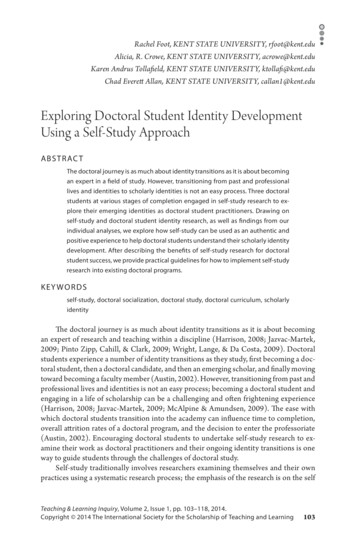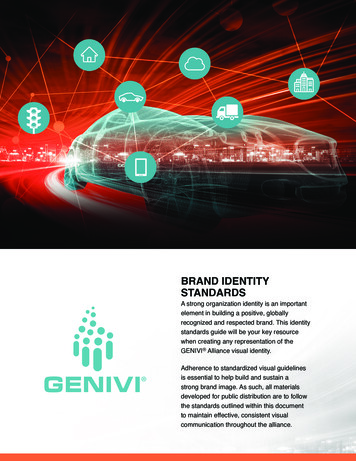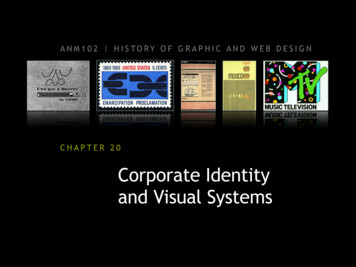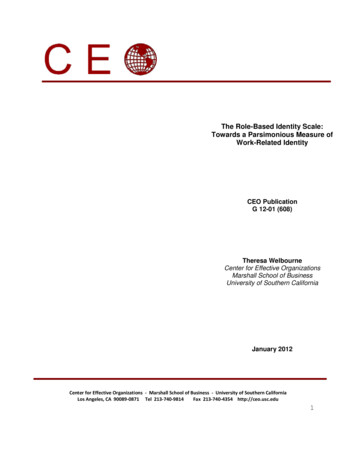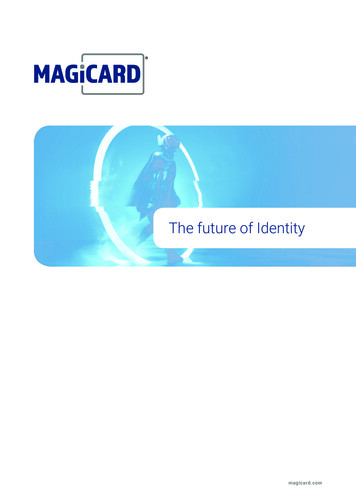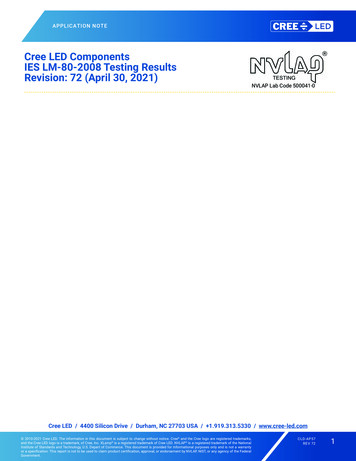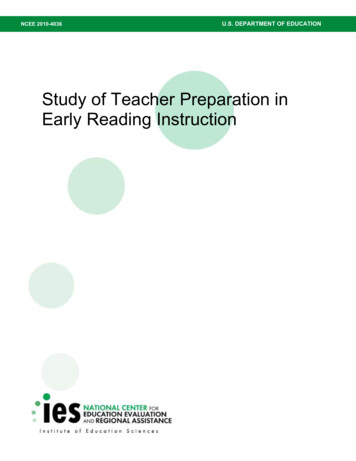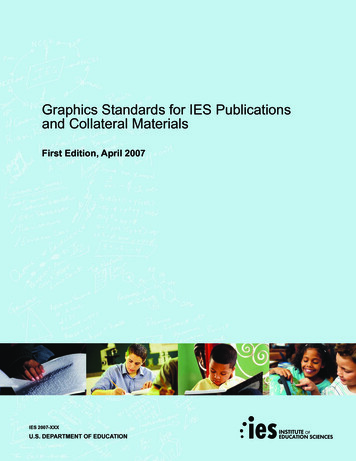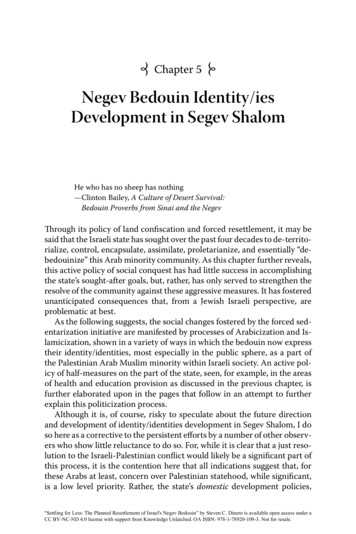
Transcription
[ Chapter 5 ]Negev Bedouin Identity/iesDevelopment in Segev ShalomHe who has no sheep has nothing—Clinton Bailey, A Culture of Desert Survival:Bedouin Proverbs from Sinai and the NegevThrough its policy of land confiscation and forced resettlement, it may besaid that the Israeli state has sought over the past four decades to de-territorialize, control, encapsulate, assimilate, proletarianize, and essentially “debedouinize” this Arab minority community. As this chapter further reveals,this active policy of social conquest has had little success in accomplishingthe state’s sought-after goals, but, rather, has only served to strengthen theresolve of the community against these aggressive measures. It has fosteredunanticipated consequences that, from a Jewish Israeli perspective, areproblematic at best.As the following suggests, the social changes fostered by the forced sedentarization initiative are manifested by processes of Arabicization and Islamicization, shown in a variety of ways in which the bedouin now expresstheir identity/identities, most especially in the public sphere, as a part ofthe Palestinian Arab Muslim minority within Israeli society. An active policy of half-measures on the part of the state, seen, for example, in the areasof health and education provision as discussed in the previous chapter, isfurther elaborated upon in the pages that follow in an attempt to furtherexplain this politicization process.Although it is, of course, risky to speculate about the future directionand development of identity/identities development in Segev Shalom, I doso here as a corrective to the persistent efforts by a number of other observers who show little reluctance to do so. For, while it is clear that a just resolution to the Israeli-Palestinian conflict would likely be a significant part ofthis process, it is the contention here that all indications suggest that, forthese Arabs at least, concern over Palestinian statehood, while significant,is a low level priority. Rather, the state’s domestic development policies,"Settling for Less: The Planned Resettlement of Israel's Negev Bedouin” by Steven C. Dinero is available open access under aCC BY-NC-ND 4.0 license with support from Knowledge Unlatched. OA ISBN: 978-1-78920-109-3. Not for resale.
120Settling for Less: The Planned Resettlement of Israel’s Negev Bedouinpriorities, and agenda, and not its foreign policy concerns, are central tostaving off what is referred to in the mainstream Jewish Israeli academicand media publications as an impending “bedouin intifada.”The Re-Definition of “Bedouinism”in the Twenty-first CenturyBefore it is possible to deconstruct twenty-first century Negev bedouinidentity/identities development and composition in the post-nomadic Israeli context, it is first necessary to acknowledge and address the changingnature of bedouinism and bedouin behaviors and identity construction,which exist throughout the Middle East and North Africa (MENA) today.While the bedouin of the Negev are situated in a unique and exceptionalset of circumstances, their situation must be contextualized within the vastset of changes now taking place in bedouin communities throughout theregion.One of the most recent and complete analyses of the changing meaning and “fluidity of Bedouin-ness” is made by Cole (2003). While Cole acknowledges that there are certain cultural markers (hospitality, honor) thathave historically typified bedouin communities, he states from the outsetthat all/most of bedouin societies and cultures today are in the midst of severe change. Given that bedouinism is a lifestyle and not a national/ethnicgroup,* it is clear that as the bedouin lifestyle changes, so too is the senseand expression of identity/identities that go along with it.This is seen most profoundly in the negative manner in which bedouinhistorically viewed settled life. In recent years, bedouin communities throughout the MENA have accepted a settled lifestyle—some voluntarily, some farless so—with the recognition that it allows and facilitates access to publicservices, modern conveniences (Cole 2003: 247), healthcare, education, andthe like. But such a lifestyle change, Cole argues, in which most bedouintoday typically reside in permanent housing, where herds may be “visited”by family members, but are tended by hired hands for wages (2003: 249),suggests that bedouinism, and the nomadic behaviors embedded within it,no longer has the resonance or the relevance that it once had.Bedouin identity in the MENA does continue to be expressed throughtribal connections, however. Unlike the capitalist West, neither geographic/residential connections to place, nor one’s occupation, have replaced tribalaffiliation as the primary factor in identity construction. And yet, Cole suggests, as bedouinism declines as an economic and social system, “one mightargue that an emergent ethnicity is replacing tribal identities of the past”(2003: 252).This open access library edition is supported by Knowledge Unlatched. Not for resale.
Negev Bedouin Identity/ies Development in Segev Shalom 121Cole is “hesitant to overstress” this new ethnicity as something greaterthan Arabness itself and it need not be viewed as such. But what can be saidhere is that what he is referring to is an “ethnicity” that, unlike the bedouinism of the past, may be defined by what these post-nomads do not do, orare lacking. The bedouin of today, he suggests, are those who have an ancestral/historical connection to the herd, that is, to those animals they usedto have (Cole 2003: 259). Their identity is based in large part not upon whothey are, but on who they are not (Cole 2003: 254). In a word, bedouin identity in the MENA today is being expressed in terms of deprivation, both interms of what was once theirs and is now lost, as well as in relation to thatwhich is possessed by those around them (culture, access to wealth, employment, and so on), motivating them to “rebellion or resistance againstthe dominant political economy” (Cole 2003: 253).The formulation of communal identity based upon perceptions of: 1)who you are, and who you are not, as well as 2) who you perceive yourselfto be versus who others perceive you to be, is central to the discussion athand. A significant aspect of bedouin identity formulation in Arab statesstems, in part, from stereotyped images of the bedouin as tribespeople,which differentiate them from the rest of Arab society (Altorki & Cole2006: 649). In the Negev case, however, bedouin identity formulation todayis almost entirely fostered by external forces, that is, based not only uponendogenous changes experienced by similar nomadic peoples throughoutthe Arab Middle East and the world as a whole in the present-day globalizing era, but, rather, also by exogenous factors rooted in the perceptionsand fears of others.Moreover, much of the academic literature and media well reflects bedouin identity as one of “other,” developed as a byproduct of the Jewish/Zionist narrative, rather than as an introspective process to be carried outby those actually undergoing the changes within their community. Thisnarrative is founded largely upon a principle not simply of identifying whois to be included in the Israeli collective, but by who is by definition outsideof the collective bounds. Thus, the early Zionist movement’s “institutionssystematically excluded Arabs since their very raison d’etre was this exclusion” (Shafir & Peled 2002: 44, emphasis added).This ideology continues to inform present day Israeli discourse. Forexample, as the state seeks to conquer and control land/space, terms suchas the “Judaization” of Israel/Palestine (Yiftachel 2003: 42) and the “deArabization of space” (27) are bandied about, seemingly suggesting thatspace carries with it the identity of a people, and through the conquest ofthat land, so too are the people, and the identities they hold, erased orcleansed, “whited-out,” and replaced with Jewishness. But, of course, theidentity changes taking place among the bedouin of the Negev today are farThis open access library edition is supported by Knowledge Unlatched. Not for resale.
122Settling for Less: The Planned Resettlement of Israel’s Negev Bedouinmore complex and nuanced than this, and such binaries, easy as they maybe to understand, do not offer a complete picture of the situation at hand.For decades, Jewish Israeli scholars have long used such dichotomiesregularly in their definitions of the minorities of Israel, typically presenting Arabness as having features which “are often diametric oppositions offeatures many [Jewish] Israelis see as typical of their own identity” (Rabinowitz 2002: 307). Such binaries thereby foster the use of oppositionalrelationships (us/them, modern/traditional, urban/rural, developed/undeveloped, advanced/primitive) and so on. In essence, in other words, JewishIsraeli scholars have typically presented the Arab minorities as the “antiJews.” Such “anti-Jews” may, Rabinovich argues, be typified as providinga counter-narrative to Zionist ideology, as “the underlying emphasis of allthese features [of Zionism, based] on modernization, hope, and vision isimplicitly strengthened by the depiction of the ultimate other as possessingdiametrically opposed characteristics” (2002: 319, emphasis added).The bedouin of the Negev have long been viewed within this context as“peculiar and exotic,” living a “life at the margin [but in] the process ofmodernization that brings an era to an end” (Rabinowitz 2002: 309–310).Meir’s As Nomadism Ends, (1997), is but one of many examples of this tradition-modernity continuum, in which bedouinism is at one end and modern Jewish Israeli society is at the other, and the “traditional” lifestyle slowlybut surely ceases to exist as patterns of nomadism weaken and stagnate inthe face of new processes of sedentarization and development in the modern Jewish state.Thus, concludes Rabinowitz, the Negev bedouin have long been presented to a receptive Jewish public as both “geographically marginal andpolitically dependent—the opposite of being metropolitan and self-reliant”(2002: 317). In order to better understand and contextualize this changingsense of identity in Negev bedouin society—as defined both internally aswell as by those outside of the community—it will be helpful to examinehow identity patterns were first formulated prior to the forced resettlementinitiative of the 1960s.Lastly, it must also be recognized that while such identities as “bedouin”and “Israeli” are quite slippery and malleable and need not (indeed, shouldnot) be equated here with “pastoralist” and “Jew,” respectively, so too aresuch identity markers as “Arab,” “Muslim,” and similar terms subject to awide degree of interpretation. While, quite obviously, the Negev bedouinbelonged to the larger Arab and Muslim collectives prior to sedentarization, their senses of identity and membership in and with those collectivesis undergoing alteration in the post-nomadic period. As but one example,the practice of regularly attending formally held religious prayer serviceswithin a mosque setting is not something that was historically part of bedThis open access library edition is supported by Knowledge Unlatched. Not for resale.
Negev Bedouin Identity/ies Development in Segev Shalom 123ouin culture and society. As will be seen below, this has begun to change inthe settled/urban environment, both a reflection of, as well as an incubatorfor, the development of a variety of newly developing ideals, values, andpractices.Identity in the Negev Before and After De-TerritorializationAs discussed in previous works (Dinero 1999; 2004), identity/identitiesformulation among the Negev bedouin was situated within two interrelated contexts. At the “micro” level, identity formulation stemmed fromone’s place within one of three different allied groups, ‘Arab (tribesmen),fellahin (peasants), and Abid (blacks/“Africans”). Members of the ‘Arab arerecognized by the others as the “True” bedouin of the region, with the mostnoble heritage. These tribes originated in the Arabian peninsula (some, likethe Azazmeh, via the Sinai), most arriving in the Negev beginning in thelatter years of the eighteenth century (Kressel et al. 1991), likely coincidingat some point with Napoleon’s Palestinian ventures (Bailey 1980: 36).Ethnicism in bedouin society may be demarcated by the arrival of thefellahin to the Negev thereafter in the nineteenth century. They, as wellas a community of blacks who at one time served as slaves to the “True”bedouin, were viewed by the “True” as socially inferior (Marx 1967). Theseblack or “African” bedouin had, until slavery was outlawed with the creation of the state, served in a variety of roles, looking after animals, caringfor crops, and carrying out household duties (Beckerleg 2007: 295).This increased social heterogeneity of a previously homogenous society,combined with greater population pressure on the land, created new political tensions and competition from within for scarce resources. As suggested above, this stratification continued to strengthen throughout thetwentieth century and is manifested today in a variety of developmentalways in Segev Shalom and the other planned towns.In addition to these internal divisions within the in-group, however,traditional Negev bedouin identity was also constructed in terms of howcommunity members saw themselves in counter-distinction from the outgroup non-bedouin majority around them. The Israeli case is complicatedfurther by the fact that the non-bedouin, that is, the Jewish Israelis, are alsonon-Arab, non-Muslim, and are historical enemies to both of these latter groups as a result of the uprooting of the Palestinian Arab population,which resulted during the creation of the State of Israel in 1948.At the “macro” level of the Negev bedouin world, one may identify twogroups, El-‘Arab (Arabic: Arabs) or El-Bedu (Arabic: the bedouin community as a whole), and El-Yahud (Arabic: the Jews). Significantly, one needThis open access library edition is supported by Knowledge Unlatched. Not for resale.
124Settling for Less: The Planned Resettlement of Israel’s Negev Bedouinnot embrace the Jewish religion or be an ethnic Jew in order to be considered a member of the realm of El-Yahud. That is, anyone not inside the collective is an outsider and is viewed in opposition to “bedouinness,” at leastas defined within this context.Just as bedouin attitudes toward the Jews well typify their minority status, Jewish attitudes toward the bedouin similarly fit the dominant groupparadigm. Historically, the Arabs of Israel, including the bedouin, have heldseparate identities as compared to Jewish Israelis. The inability to access“Israeliness” in a nationality sense, due to the separate status held by Israel’sArab citizens, is in part a reflection of an existing system of inequality andseclusion that has plagued the community since the creation of the state(Grossman 1993).The issue of Israeli identity, of who is or is not an Israeli, is not easilyunraveled. Jews who see Israeliness as an extension of Jewishness (or viceversa) by definition exclude the minorities from the equation altogether.Issues related to the Jewish symbolism of what is in truth a binational state,such as the National Anthem and the flag, offer Jewish Israelis a sense ofidentity that by definition excludes the Arab communities. It is importantto note, however, that an expressed sense of “Israeliness” had slowly beenon the rise among the Arab communities from the mid 1970s through themid 1990s, but this trend saw a sharp decrease throughout this sector according to national polls beginning in the late 1990s (Ghanem & Smooha2001).Moreover, as will be elaborated upon further below, the idea of one seeing oneself/being seen as “Israeli” also may be moving toward being a classdistinction, at least as it is beginning to become manifest within the bedouin community. This is significant, stemming from an effort on the part ofIsrael’s planners to use the resettlement sites as socializing agents, drawingtogether a number of ‘Arab tribes, as well as fellahi and Abid groups, eachof which would reside in its own separate neighborhood (Fenster 1991).The resettlement initiative has torn the bedouin not only from their geographic roots, but also from their social connections both to one anotherand to the world in which they were formally situated. At the same time,new internal relationships between the three sub-groups previously at oddswith one another, and new connections with the dominant Jewish societyat large, have begun to take form. Increasingly, evidence suggests that theNegev bedouin community is internally divided not as it once was, but,rather, between those who have opted for an “urbanized” lifestyle and thosewho continue to resist the government’s relocation initiative. Further, bedouin identity today is increasingly defined by interactions with the dominant Jewish society at large.This open access library edition is supported by Knowledge Unlatched. Not for resale.
Negev Bedouin Identity/ies Development in Segev Shalom 125Upon first entering bedouin towns today, one is often met with the samerepeated refrain, here summed up by a Segev Shalom shopkeeper who livesin the pezurah, in an encounter I had with him in early March 2007, whenhe confronted me in halting, broken English:Why did you come here [to Segev Shalom] to learn about the bedouin?!You can’t learn anything here! Do you have a car? Drive out there [pointing towards the hills to the East], go nearer to the mountains. There, youwill find bedouin. Not here! When we lived out in the desert, we were free.We lived there without limitations. That’s not how it is in the town.Such attitudes are ever-present throughout bedouin society today, and reflect the views expressed to me years ago that, as the resettlement initiativetakes hold and the tent becomes a thing of the past, “there are no morebedouin” in the Negev (Dinero 1999: 25).Haidar, a local café worker in Segev Shalom, was one of many resettledinformants to affirm that town living and the modern values associated withit have negatively impacted bedouin life. He states in 2007:No one just sits and drinks and talks like this anymore. It’s not like fifteenyears ago—it was better then—and it was even better fifteen years beforethat. Today, everyone is running. They run here, they run there. They haveno time for anything. All anyone does anymore is just run.While such views can be attributed in part to the nostalgia that many communities tend to fall back upon during times of change and transition, thisshould not in any way weaken the power of the sentiment expressed. Ifnothing else, the fact that such attitudes sound familiar with the workaday lifestyle of many Americans and other Westerners only reinforces thefact that bedouin identity is not only fluid and layered, but at times fails toconnect with the realities of the changes that are now a very real part ofbedouin lives and lifestyles.And yet, from a Jewish planner’s perspective, such changes in who andwhat the bedouin are today well reflect and further reinforce the rationalefor the state’s resettlement initiative, essentially confirming and affirmingthe need to facilitate still further the de-nomadization/“modernization”planning process, especially among the youth. As Dudu Cohen puts it (24April 2007):It’s clear today that the process that the bedouin are going through is a societal change, cultural change, mentality change, but apparently, you haveto go through it. It’s not immediate and so, it’s clear to every one thatThis open access library edition is supported by Knowledge Unlatched. Not for resale.
126Settling for Less: The Planned Resettlement of Israel’s Negev Bedouinit’s a process. It’s a long process that will take its own time Every societyadapts differently to change of this kind. But in the end it will happen,because the bedouin are being absorbed into Jewish Israeli society [So now you hear] “Listen, my children want Nike shoes.” Once, bedouindidn’t think like this. But because he and his kids are walking around themall in Be’er Sheva, meeting other kids, or his children are studying inOmer [sic] and not in Laqiya, suddenly his children think differently, [they]want different things. So this absorption into the Jewish society, the moremodern Israeli society, causes the bedouin to ‘go up’ a little bit higher.The planning initiative seeks not only to alter bedouin identity through exposure to “modern Jewish values,” but, similarly, to break down the traditional divisions between the ‘Arab, fellahi, and Abid sub-groups, “meshing”and interweaving them in a manner that will de-emphasize and eventuallybreak down the historic/traditional bedouin communal structure (Dinero1999: 25–26). Moshe Moshe, a planner for the Bedouin Authority, has suggested that such interactions are similarly playing a role in the developmentof a new bedouin culture and identity (15 February 2007):There’s another thing here. I’m not pointing this out in a racist way. Davka[Hebrew: on the contrary, of all things] the bedouin themselves point thisout. [And that is that] there are the fellahin. I’ll give you a sentence andI don’t care if you quote me anywhere or not, because I say it straight totheir faces. The [‘True’] bedouin is lazy. He doesn’t like to work. He likes itwhen someone else does the work for him. Let him sleep and let him getup at 11:00 in the morning and say, “Ya, Daughter, where’s the nargeelah[Arabic: water pipe]? And who does the work for him? The fellah. So hedoesn’t have any choice but to put the fellah right next to him.Now, if the fellah wasn’t here, what you see here [in the towns] todaywouldn’t be here. Because he, in essence, gives the stimulation to the[‘True’] bedouin to go in the direction of business, the direction of educational enlightenment. He did that—the fellah.As was previously noted, the fellahi bedouin have played a key role in thesedentarization process. Still, it is difficult to interpret Moshe’s words asless than sharp, even if his sentiment, as well as that of Cohen and othergovernment officials, recognizes the significance of the transitions now occurring within bedouin social structures and the identities that these structures embodied. Thus, this recognition is loaded with certain assumptions,ideology, attitudes, and judgments that are often counter-productive to thedevelopmental goals that they are charged to fulfill.This open access library edition is supported by Knowledge Unlatched. Not for resale.
Negev Bedouin Identity/ies Development in Segev Shalom 127Before turning to the quantitative data to further illustrate these changesin greater detail, I offer the following unfiltered views as expressed by anordinary Segev Shalom shop owner (6 March 2007), as they, I believe, standin stark contrast with the perspective of many Jewish State officials. Theviews expressed are also useful in the way that this bedouin town dweller,without any prompting on my part, summarizes the issues taking placewithin bedouin society, as well as how Jewish Israelis view the bedouinwithin the regional context in which these changes are manifest:We’re progressing, but we don’t really feel it. In the last ten to fifteen years,people have changed for the worse. In the past, if someone died, no onewould have a wedding out of respect. Now, someone dies, and their nextdoor neighbor will have the wedding [anyway]. Or someone is drivingto Be’er Sheva and sees someone who needs a ride and drives right pastthem. People think only about themselves now.Why? Because of money. In the past, we had very little. Now people havequite a bit. But in the past, people would just gather at night in the shiqof one of the tents and drink and eat and talk about who was sick, whodied, who was getting married. Now, in town, everyone has their own shiq[Arabic: public sitting area of a tent] in their house. No one sits together.Everyone wants to be their own sheikh.Before the [2000] intifada, we were bedouin, and then there were the Palestinians [in the Territories]. But after the intifada started, they [the IsraeliJews] looked at us and looked at them and said ‘you’re Arabs. They are Arabs, you are Arabs, it’s all the same thing.’ [In truth] the Palestinians used tolive well. Their world and our world wasn’t so different. They lived in villas.Now, we live in different worlds. Things have gotten very bad for them. Butthe Jews here live in a different world than us too. It is like the differencebetween ‘the heavens and the earth’ [a reference to the Hebrew bible].Data Analysis in Segev Shalom:The Results of De-BedouinizationThe qualitative material above provides one aspect of the changing senseof identity, as expressed internally and as viewed from outside of the Negevbedouin community. Quantitative data gathered over more than a decadein Segev Shalom further informs how identity development is being expressed in the resettled Negev bedouin community.In order to attempt to parse out how the bedouin see themselves, the1996, 2000, and 2007 survey respondents were first asked to provide a oneThis open access library edition is supported by Knowledge Unlatched. Not for resale.
128Settling for Less: The Planned Resettlement of Israel’s Negev Bedouinor two word definition of themselves and their families (Table 5.1). Suchlabels are one form of expression that can be used, along with other criteria, to measure how one sees oneself and situates oneself within the publicrealm. Such self-labeling suggests shared affinities for some groups, as wellas opposition for still others (i.e., who one “is” and who one “isn’t”).While it is clear that the term bedouin was the primary identifying labelfor over three-quarters of the survey respondents in 1996, with one-quarterchoosing alternative primary labels and over 20 percent not including theterm bedouin as either a primary or even a secondary term of identity, thiswas no longer true by 2000. The term bedouin had been replaced, mostlyby the term Arab (nearly 40 percent), although Muslim was also chosen bymore than 20 percent of respondents.The term Israeli, alone or as a suffix or prefix to an identity label, wasbarely mentioned by survey respondents in 1996, short of the 2 percentwho chose it as a secondary label. Similarly, the term Israeli-Arab, theidentity label of choice utilized throughout Israeli media and governmentcircles, was only cited by 6 percent of the survey respondents as either aprimary or secondary identity label. Four years later, the identifier was stillnot used a great deal, though it was chosen by more than 10 percent of thesurvey respondents.By 2007, the picture of self-identification appeared to be somewhatclearer. The percentage of those who chose the bedouin identity label werevirtually unchanged from the 2000 results. Those choosing the Palestinian label similarly held somewhat constant over the study period. But whathas changed significantly is the percentage of those who have chosen theIsraeli label, which has dropped considerably. More dramatically still, thepercentage of those now choosing Muslim as their primary identity label,50 percent of those surveyed, has risen from less than 10 percent only a decade earlier. I will return to this issue in further detail below.Regarding Segev Shalom residents’ sense of belonging to the larger Israeli collective, the respondents’ answers (Table 5.2) confirm that the vastmajority of those surveyed in 1996, 2000, and 2007 did not feel that theyreceive equal treatment under the law, despite the fact that they are Israelicitizens.Overall, poorer/lower income residents who are newcomers to the townare more likely to state that they feel less equal with other Israelis (p .05).The Tarabeen who have been in Segev Shalom the longest are more likely toexpress a greater sense of equality with Jewish Israelis than Tarabeen newcomers ( p .04). The number that answered “yes” to the question, roughly20 percent, is just slightly lower than statistics from similar studies askingsimilar questions about bedouin sense of well-being and inclusion (ex. 29percent; see Abu-Saad, Yonah, and Kaplan 2000: 57). Although it is apparThis open access library edition is supported by Knowledge Unlatched. Not for resale.
Negev Bedouin Identity/ies Development in Segev Shalom 129Table 5.1. Identity Labels1996 (N 102)2000 (N 144)2007 (N 232)ArabArab PalestinianArab MuslimArab bedouinArab Israeli; Arab PalestinianIsraeli; Arab Israeli-Arab—ARAB nian ArabPalestinian Israeli-Arab; MuslimPalestinian Bedouin—PALESTINIAN 2.60.46.9MuslimMuslim ArabMuslim PalestinianMuslim BedouinMuslim Israeli; Muslim IsraeliArab; Muslim Palestinian-Israeli—MUSLIM 9.93.975.46.919.42.119.0BedouinBedouin ArabBedouin PalestinianBedouin MuslimBedouin Israeli; Bedouin IsraeliArab; Bedouin Palestinian-Israeli—BEDOUIN totalIsraeli-ArabIsraeli MuslimIsraeli BedouinIsraeli Israeli-Arab;Israeli-Arab IsraeliIsraeli-Arab MuslimIsraeli-Arab Bedouin—ISRAELI 0.012.61.80.42.76.1Other2.20.00.0Sources: Dinero, S.C. “Reconstructing Identity Through Planned Resettlement: The Case ofthe Negev Bedouin,” Third World Planning Review, 21/1, 1999: 19–39; “New Identity/IdentitiesFormulation in a Post-Nomadic Community: The Case of the Bedouin of the Negev,” NationalIdentities, 6/3, 2004: 261–275, and Dinero, S.C. 2007 Segev Shalom Household Survey.This open access library edition is supported by Knowledge Unlatched. Not for resale.
130Settling for Less: The Planned Resettlement of Israel’s Negev Bedouinent that this sentiment is slowly on the decline for men and women alike,this contention wa
Negev Bedouin Identity/ies Development in Segev Shalom 123 ouin culture and society. As will be seen below, this has begun to change in the settled/urban e
